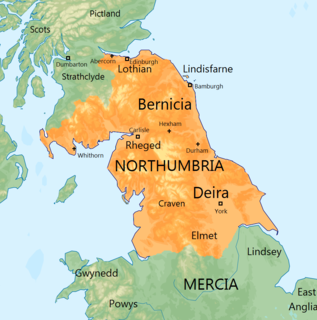Cælin was one of four brothers named by Bede as active in the early Anglo-Saxon Church. The others were Cedd, Chad, and Cynibil.

Bede, also known as Saint Bede, Venerable Bede, and Bede the Venerable, was an English Benedictine monk at the monastery of St. Peter and its companion monastery of St. Paul in the Kingdom of Northumbria of the Angles. Born on lands likely belonging to the Monkwearmouth monastery in present-day Sunderland, Bede was sent there at the age of seven and later joined Abbot Ceolfrith at the Jarrow monastery, both of whom survived a plague that struck in 686, an outbreak that killed a majority of the population there. While he spent most of his life in the monastery, Bede travelled to several abbeys and monasteries across the British Isles, even visiting the archbishop of York and King Ceolwulf of Northumbria. He is well known as an author, teacher, and scholar, and his most famous work, Ecclesiastical History of the English People, gained him the title "The Father of English History". His ecumenical writings were extensive and included a number of Biblical commentaries and other theological works of exegetical erudition. Another important area of study for Bede was the academic discipline of computus, otherwise known to his contemporaries as the science of calculating calendar dates. One of the more important dates Bede tried to compute was Easter, an effort that was mired with controversy. He also helped establish the practice of dating forward from the birth of Christ, a practice which eventually became commonplace in medieval Europe. Bede was one of the greatest teachers and writers of the Early Middle Ages and is considered by many historians to be the single most important scholar of antiquity for the period between the death of Pope Gregory I in 604 and the coronation of Charlemagne in 800.

Cedd was an Anglo-Saxon monk and bishop from the Kingdom of Northumbria. He was an evangelist of the Middle Angles and East Saxons in England and a significant participant in the Synod of Whitby, a meeting which resolved important differences within the Church in England. He is venerated in Anglicanism, the Catholic Church and the Eastern Orthodox Church.

Chad was a prominent 7th century Anglo-Saxon churchman, who became abbot of several monasteries, Bishop of the Northumbrians and subsequently Bishop of the Mercians and Lindsey People. He was later canonised as a saint. He was the brother of Cedd, also a saint. He features strongly in the work of Bede the Venerable and is credited, together with Cedd, with introducing Christianity to the Mercian kingdom.
The name Caelin is a spelling variant of the name of a West Saxon king Ceawlin, and is of Celtic rather than Anglo-Saxon derivation. [1]

Ceawlin was a King of Wessex. He may have been the son of Cynric of Wessex and the grandson of Cerdic of Wessex, whom the Anglo-Saxon Chronicle represents as the leader of the first group of Saxons to come to the land which later became Wessex. Ceawlin was active during the last years of the Anglo-Saxon expansion, with little of southern England remaining in the control of the native Britons by the time of his death.
Bede portrays Cælin as a chaplain at the court of Ethelwald, a nephew of King Oswiu of Northumbria. Ethelwald was appointed to administer the coastal area of Deira. It was on the initiative of Cælin that Ethelwald donated land for the building of a monastery at Lastingham in the North York Moors. The monastery became a base for Cedd, who was serving as a missionary bishop in Essex, and for Chad, who succeeded him as abbot.
Œthelwald was a King of Deira. He was the son of King Oswald of Northumbria, who was killed at the Battle of Maserfield in 642.

Lastingham is a village and civil parish which lies in the Ryedale district of North Yorkshire, England. It is on the southern fringe of the North York Moors, 5 miles (8.0 km) north-east of Kirkbymoorside, and 1.5 miles (2.4 km) to the east of Hutton-le-Hole. It was home to the early missionaries to the Angles, St. Cedd and his brother, St. Chad. At the 2001 census, the parish had a population of 96, increasing to 233 at the 2011 Census.

The North York Moors is an upland area in North Yorkshire, England, containing one of the largest expanses of heather moorland in the United Kingdom. The North York Moors National Park was designated in 1952, through the National Parks and Access to the Countryside Act 1949. The National Park covers an area of 554 sq mi (1,430 km2), and has a population of 23,380.






